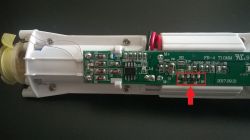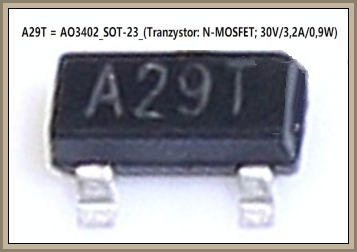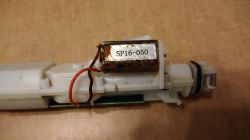FAQ
TL;DR: Many Nevadent/Lidl irrigators fail after 3.5 years; symptom: "turns on and quietly squeaks." This FAQ shows fast checks and safe opening steps. [Elektroda, ropi, post #18277971]
Why it matters: For DIY owners of Nevadent/Lidl and Panasonic EW1211-like irrigators, this saves time, avoids damage, and guides repair-vs-return decisions.
Quick Facts
- Hidden fastener: a top screw sits under an upper rectangular piece; gently tilt it to access. [Elektroda, kamk88, post #17373678]
- Power switchers: parts marked A29T map to AO3402 N‑MOSFETs, SOT‑23, 30 V / 3.2 A / 0.9 W. [Elektroda, TONI_2003, post #17429259]
- Charging failures: one unit stopped after 1 week; it still charged on a Braun toothbrush charger with the bottom cap off. [Elektroda, HashMap, post #20473882]
- Long‑term symptom: after 3.5 years, multiple units "turn on and quietly squeak" yet do not pump; warranties were honored. [Elektroda, ropi, post #18277971]
- Upper module: a motor labeled SP16‑050 was seen with an unconnected shaft; function not confirmed. [Elektroda, power_pc, post #17609413]
How do I access the hidden top screw without damaging the rectangular block?
Lift the upper housing and look for a small rectangular piece sitting over the screw. Do not peel it off. Gently tilt the piece to expose the screw and unscrew it. As one user noted, "I did not peel off anything, I slightly tilted this rectangular element and I could easily unscrew the screw." [Elektroda, kamk88, post #17373678]
How do I remove the electronics module after loosening the top screw?
- Locate the additional screw inside the upper housing.
- Unscrew it to release the assembly.
- Slide the electronics out from the bottom of the handle for inspection.
This sequence frees the board and power components for testing or part replacement. [Elektroda, kamk88, post #17360881]
What is the A29T transistor and what are its key specs?
A29T corresponds to the AO3402 N‑channel MOSFET in SOT‑23. Typical board-level specs noted are 30 V, 3.2 A, and 0.9 W. If your A29T parts are burnt, match both the marking and package when ordering replacements. These devices commonly switch motor or pump loads in compact appliances. [Elektroda, TONI_2003, post #17429259]
On a working Nevadent unit, what transistor marking should I expect?
A user verified on an intact, working irrigator that the small three‑pin switching devices carry the A29T marking. This helps confirm part selection when diagnosing burn marks or replacing components on a failed board. [Elektroda, kamk88, post #17427251]
Are those 3‑pin parts with a 'Q' on the silkscreen actually transistors?
Yes. The board uses the 'Q' designator for three‑lead semiconductors, and the pointed parts in question were confirmed as transistors. Some devices lacked visible top codes after heat damage, which can mislead identification during repairs. [Elektroda, ropi, post #17373787]
My irrigator turns on and squeaks but won’t pump. Did others see this?
Yes. One owner reported units that power on and "quietly squeak," yet fail to pump water after several years. Their warranty claims were recognized. This symptom points to internal electronics trouble rather than a simple nozzle clog. Consider repair attempts or replacement under warranty. [Elektroda, ropi, post #18277971]
Can I charge a Nevadent irrigator on a Braun toothbrush charger if the dock fails?
One user removed the bottom cap and set the irrigator on a Braun toothbrush charger. The battery charged, indicating a failed internal charging module. That unit had stopped charging after only 1 week. This can be a useful diagnostic or temporary workaround. [Elektroda, HashMap, post #20473882]
What is the small top motor labeled SP16‑050?
A user observed an additional motor labeled SP16‑050 in the upper housing. The motor shaft was not mechanically connected to anything visible. Its function was not confirmed in that teardown snapshot. Treat it as a non-drive component until proven otherwise. [Elektroda, power_pc, post #17609413]
Does Panasonic provide a schematic for the EW1211‑like board?
No. The report notes Panasonic service treats the whole electronics module as a replaceable part. An official schematic was not provided, complicating component-level diagnosis. Plan to reverse-engineer locally if you need deeper circuit insight. [Elektroda, ropi, post #17382881]
Is the Nevadent design similar to the Panasonic DentaCare EW 1211?
Yes. The thread opener states the Nevadent unit is very similar to the Panasonic DentaCare Handy EW 1211. This guides expectations for internal layout and typical components during disassembly and inspection. [Elektroda, ropi, post #17356069]
I thought my capacitors burned—could they be mislabeled transistors?
That happened in the thread. The damaged parts had three legs and a 'Q' designator, indicating transistors rather than capacitors. Verify the silkscreen and pin count before ordering replacements, especially near the power switching stage. [Elektroda, ropi, post #17373787]
Any edge cases after the first full discharge I should watch for?
Yes. One report said the irrigator worked until the first discharge, then issues appeared around charge and power-on behavior. Treat first deep discharge and immediate charging attempts as a potential stress event during diagnostics. [Elektroda, walmich, post #17695331]
Are mains voltage swings a risk for the charger?
A user attributed repeated charger problems to line fluctuations, stating, "I suppose that the chargers fail when the mains voltage changes." If your grid is unstable, protect the dock with a surge suppressor. [Elektroda, ropi, post #20474409]
Are the power transistors a likely failure point on dead boards?
One repair attempt found very low battery state and suspected damaged transistors. The author planned to recreate part of the schematic from the PCB to continue diagnosis. Check A29T devices and nearby traces for thermal damage. [Elektroda, ropi, post #17382881]
How can I identify the battery once the unit is open?
After removing the top screw and sliding the electronics out, you can inspect the battery directly. In one teardown, the owner accessed it and noted the battery was almost empty during fault finding. Examine the cell label once exposed. [Elektroda, ropi, post #17382881]









